小学英语语法内容总结及练习
小学英语语法及练习题
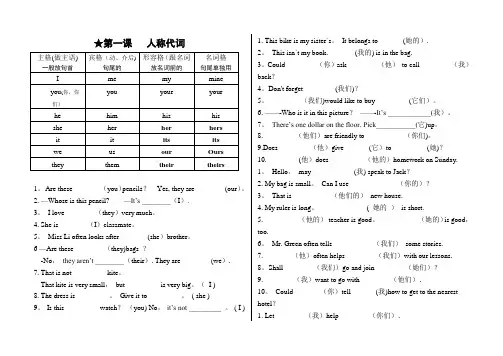
★第一课人称代词1。
Are these ________(you)pencils?Yes, they are ________(our)。
2. —Whose is this pencil? —It’s ________(I).3。
I love ________(they)very much。
4. She is________(I)classmate。
5。
Miss Li often looks after________(she)brother。
6 —Are these ________(they)bags ?-No,they aren’t ________(their). They are ________(we).7. That is not _________ kite。
That kite is very small,but _________ is very big。
(I )8. The dress is _________。
Give it to _________。
( she )9。
Is this _________ watch?(you) No,it’s not _________ 。
( I ) 1. This bike is my sister`s。
It belongs to ______ (她的).2。
This isn`t my book. _______(我的) is in the bag.3。
Could_________(你)ask_________(他)to call_________(我)back?4。
Don't forget_________(我们)?5。
_________(我们)would like to buy_________ (它们)。
6. ——-Who is it in this picture?——-It’s ____________(我)。
7。
There’s one dollar on the floor. Pick___________(它)up。
外研社小学英语一起小学5五年级下语法总结及练习题
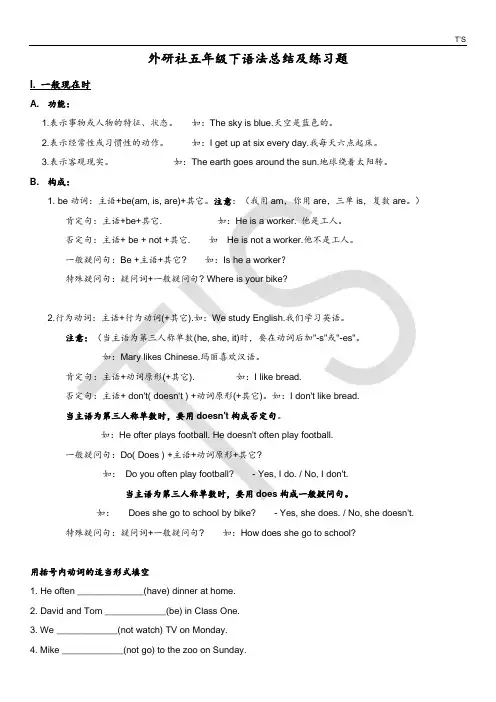
外研社五年级下语法总结及练习题I. 一般现在时A. 功能:1.表示事物或人物的特征、状态。
如:The sky is blue.天空是蓝色的。
2.表示经常性或习惯性的动作。
如:I get up at six every day.我每天六点起床。
3.表示客观现实。
如:The earth goes around the sun.地球绕着太阳转。
B. 构成:1. be动词:主语+be(am, is, are)+其它。
注意:(我用am,你用are,三单is,复数are。
)肯定句:主语+be+其它. 如:He is a worker. 他是工人。
否定句:主语+ be + not +其它. 如He is not a worker.他不是工人。
一般疑问句:Be +主语+其它? 如:Is he a worker?特殊疑问句:疑问词+一般疑问句? Where is your bike?2.行为动词:主语+行为动词(+其它).如:We study English.我们学习英语。
注意:(当主语为第三人称单数(he, she, it)时,要在动词后加"-s"或"-es"。
如:Mary likes Chinese.玛丽喜欢汉语。
肯定句:主语+动词原形(+其它). 如:I like bread.否定句:主语+ don't( doesn't ) +动词原形(+其它)。
如:I don't like bread.当主语为第三人称单数时,要用doesn't构成否定句。
如:He ofter plays football. He doesn't often play football.一般疑问句:Do( Does ) +主语+动词原形+其它?如:Do you often play football?- Yes, I do. / No, I don't.当主语为第三人称单数时,要用does构成一般疑问句。
(全书完整版)人教版pep小学英语语法总结
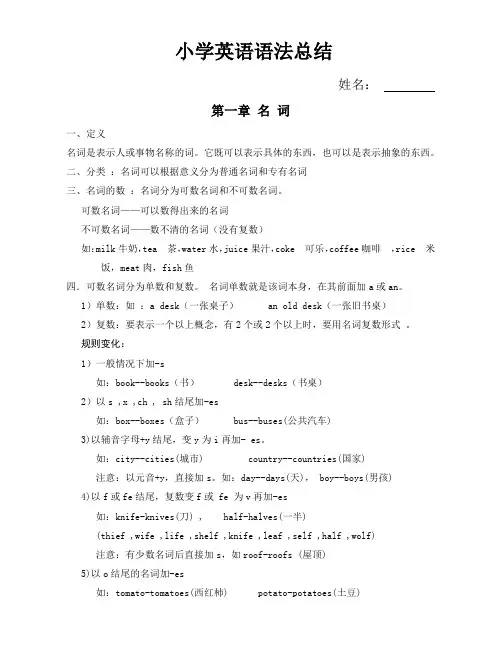
小学英语语法总结姓名:第一章名词一、定义名词是表示人或事物名称的词。
它既可以表示具体的东西,也可以是表示抽象的东西。
二、分类:名词可以根据意义分为普通名词和专有名词三、名词的数:名词分为可数名词和不可数名词。
可数名词——可以数得出来的名词不可数名词——数不清的名词(没有复数)如:milk牛奶,tea 茶,water水,juice果汁,coke 可乐,coffee咖啡,rice 米饭,meat肉,fish鱼四.可数名词分为单数和复数。
名词单数就是该词本身,在其前面加a或an。
1)单数:如:a desk(一张桌子) an old desk(一张旧书桌)2)复数:要表示一个以上概念,有2个或2个以上时,要用名词复数形式。
规则变化:1)一般情况下加-s如:book--books(书) desk--desks(书桌)2)以s ,x ,ch , sh结尾加-es如:box--boxes(盒子) bus--buses(公共汽车)3)以辅音字母+y结尾,变y为i再加- es。
如:city--cities(城市) country--countries(国家)注意:以元音+y,直接加s。
如:day--days(天), boy--boys(男孩)4)以f或fe结尾,复数变f或 fe 为v再加-es如:knife-knives(刀) , half-halves(一半)(thief ,wife ,life ,shelf ,knife ,leaf ,self ,half ,wolf) 注意:有少数名词后直接加s,如roof-roofs (屋顶)5)以o结尾的名词加-es如:tomato-tomatoes(西红杮) potato-potatoes(土豆)注意:zero 两种方式都可:zero-zeros或 zeroes(零)不规则变化1) 元音字母发变化。
如:man--men(男人) , woman--women(妇女) tooth--teeth(牙齿) ,mouse--mice(老鼠) , policeman--policemen(警察) foot--feet(脚) 2) 词尾发生变化。
小学英语语法一般过去时总结及练习
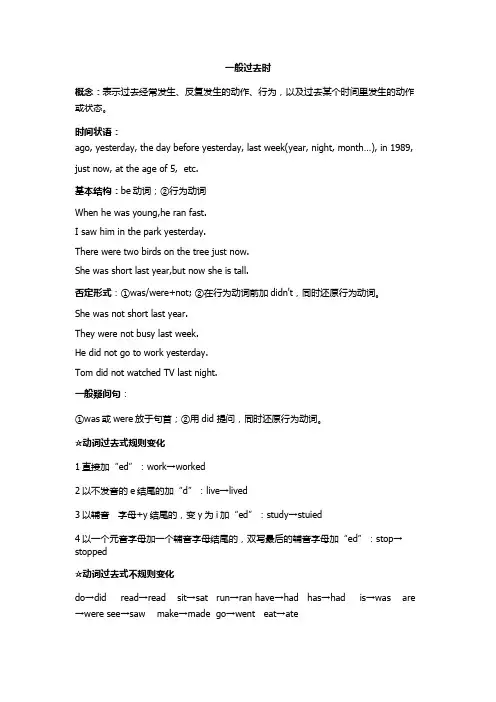
一般过去时概念:表示过去经常发生、反复发生的动作、行为,以及过去某个时间里发生的动作或状态。
时间状语:ago, yesterday, the day before yesterday, last week(year, night, month…), in 1989, just now, at the age of 5, etc.基本结构:be动词;②行为动词When he was young,he ran fast.I saw him in the park yesterday.There were two birds on the tree just now.She was short last year,but now she is tall.否定形式:①was/were+not; ②在行为动词前加didn't,同时还原行为动词。
She was not short last year.They were not busy last week.He did not go to work yesterday.Tom did not watched TV last night.一般疑问句:①was或were放于句首;②用did 提问,同时还原行为动词。
☆动词过去式规则变化1直接加“ed”:work→worked2以不发音的e结尾的加“d”:live→lived3以辅音字母+y结尾的,变y为i加“ed”:study→stuied4以一个元音字母加一个辅音字母结尾的,双写最后的辅音字母加“ed”:stop→stopped☆动词过去式不规则变化do→did read→read sit→sat run→ran have→had has→had is→was are →were see→saw make→made go→went eat→ate一般过去时的练习一、用所给的动词的适当形式填空。
⒈He ___________(visit) the Great Wall last year.2.We____________(have) a good time yesterday.3.We often __________(go) to school by bus last year.4.I __________(live)in the village when I was a child.5.Mike__________(see) a big tiger in the nature park last year.6.Sam___________ (do) the housework yesterday.7.________(do) you _________(enjoy) yourself yesterday?8.________(do)you __________(play) the violin in the artroom yesterday?9.I __________ (eat) a big pizza yesterday.10.There_________ (be) many sheep on the farm last year.11. I _________ (watch) a cartoon on Saturday.12. Her father __________ (read) a newspaper last night.13. We _________ to zoo yesterday, we ___________ to the park. (go)14. _________ you __________ (visit) your relatives last Spring Festival?15. _________ he __________ (fly) a kite on Sunday? Yes, he __________.二、单项选择( ) 1. She watered the flowers ________.A tomorrowB sometimesC yesterday morning( ) 2.What ____ Mike do last weekend ?A doB doesC did( ) 3. I ___ my room last Sunday.A cleanedB cleanC am cleaning( ) 4. _____ you _____ TV last night .A Do, watchB Did, watchC Did, watched( ) 5.---Did your father write an e-mail yesterday ?A Yes, he did.B Yes, he doesC No, he don’t( ) 6.They _____ on a trip in February ,2007.A are goingB goingC went( ) 7. ____ he ____ football two days ago?A Does , playB Did , playedC Did , play三、Be动词的过去时练习(一)用be动词的适当形式填空。
(完整版)译林小学英语语法点汇总资料
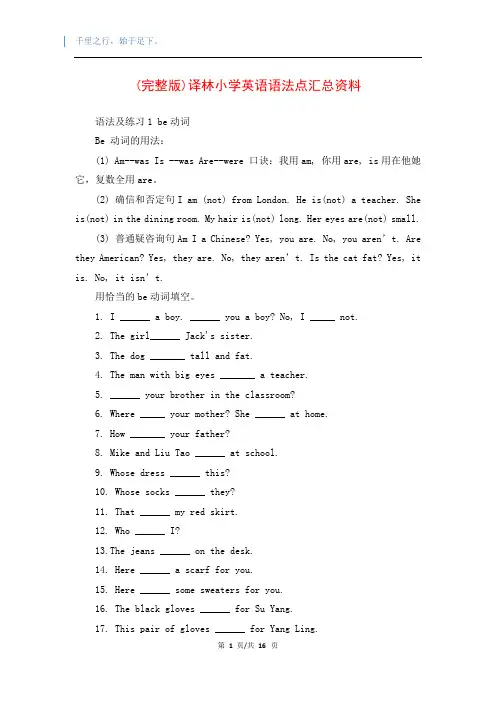
(完整版)译林小学英语语法点汇总资料语法及练习1 be动词Be 动词的用法:(1) Am--was Is --was Are--were 口诀:我用am, 你用are, is用在他她它,复数全用are。
(2) 确信和否定句I am (not) from London. He is(not) a teacher. She is(not) in the dining room. My hair is(not) long. Her eyes are(not) small.(3) 普通疑咨询句Am I a Chinese? Yes, you are. No, you aren’t. Are they American? Yes, they are. No, they aren’t. Is th e cat fat? Yes, it is. No, it isn’t.用恰当的be动词填空。
1. I ______ a boy. ______ you a boy? No, I _____ not.2. The girl______ Jack's sister.3. The dog _______ tall and fat.4. The man with big eyes _______ a teacher.5. ______ your brother in the classroom?6. Where _____ your mother? She ______ at home.7. How _______ your father?8. Mike and Liu Tao ______ at school.9. Whose dress ______ this?10. Whose socks ______ they?11. That ______ my red skirt.12. Who ______ I?13.The jeans ______ on the desk.14. Here ______ a scarf for you.15. Here ______ some sweaters for you.16. The black gloves ______ for Su Yang.17. This pair of gloves ______ for Yang Ling.18. The two cups of milk _____ for me.19. Some tea ______ in the glass.20. Gao shan's shirt _______ over there.21. My sister's name ______Nancy.22. This ______ not Wang Fang's pencil.23. ______ David and Helen from England?24. There ______ a girl in the room.25. There ______ some apples on the tree.26. _______ there any kites in the classroom?27. _______ there any apple juice in the bottle?28. There _______ some bread on the plate.29. There _______ a boy, two girls, three men and ten women in the park.语法及练习2 人称代词和物主代词人称代词和物主代词1.人称代词主格和宾格的区不:主格通常位于句中第一具动词之前(有时候位于than 之后),宾格普通位于动词或介词之后。
小学英语语法练习题及答案
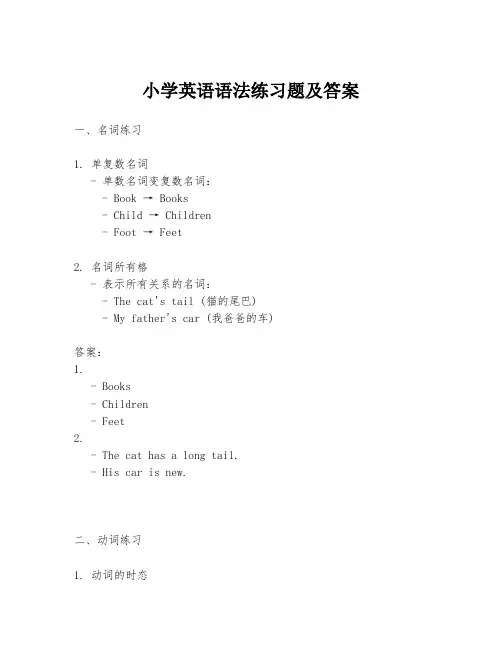
小学英语语法练习题及答案一、名词练习1. 单复数名词- 单数名词变复数名词:- Book → Books- Child → Children- Foot → Feet2. 名词所有格- 表示所有关系的名词:- The cat's tail (猫的尾巴)- My father's car (我爸爸的车)答案:1.- Books- Children- Feet2.- The cat has a long tail.- His car is new.二、动词练习1. 动词的时态- 现在进行时:- She is reading a book.- 一般过去时:- They walked to school.2. 动词的第三人称单数- He plays football every day.答案:1.- She is reading a book now.- Yesterday, they walked to school. 2.- He plays football every day.三、形容词和副词练习1. 形容词比较级和最高级- 比较级:Bigger, faster- 最高级:The biggest, the fastest2. 副词的使用- 副词修饰动词:- She runs quickly.答案:1.- The cat is bigger than the dog.- This is the fastest car in the race.2.- She runs quickly to catch the bus.四、代词练习1. 人称代词- 主格代词:I, you, he, she, it- 宾格代词:me, you, him, her, it2. 物主代词- 形容词性物主代词:my, your, his, her, its - 名词性物主代词:mine, yours, his, hers, its答案:1.- I am going to the park. (主格)- Can you pass the ball to me? (宾格)2.- This is my book. (形容词性)- The book is mine. (名词性)五、介词练习1. 表示时间的介词- In, on, at- In the morning, on Monday, at 5 o'clock2. 表示地点的介词- In, on, at, to- In the classroom, on the desk, at the zoo, to the library答案:1.- I wake up in the morning.- We have a party on my birthday.- The meeting starts at 3 PM.2.- The cat is in the box.- The book is on the table.- We go to the park.六、疑问句练习1. 一般疑问句- Do you like apples?- Does she have a sister?2. 特殊疑问句- What is your name?- Where are you going?答案:1.- Yes, I do.- No, she doesn't.2.- My name is Tom.- I am going to the cinema.。
小学英语语法要点总结及习题(附答案)
小学英语语法要点总结及习题一、名词复数规则1.一般情况下,直接加-s,如:book-books, bag-bags, cat-cats, bed-beds2.以s. x. sh. ch结尾,加-es,如:bus-buses, box-boxes, brush-brushes, watch-watches3.以“辅音字母+y”结尾,变y为i, 再加-es,如:family-families, strawberry-strawberries以“f或fe”结尾,变f或fe为v, 再加-es,(但有一个特例:roof→roofs)。
如:knife-knives leaf-leaves wife-wives thief-thieves wolf-wolves5.以“o”结尾的单词,如果有生命,加-es;如果没有生命,加-s。
如:①有生命:potato-potatoes tomato-tomatoes mango-mangoeshero-heroes Negro- Negroes②没生命:radio-radios piano-pianos photo-photos zoo-zoos6.不规则名词的复数变化:(一)完全不规则:woman-women policeman-policemen policewoman-policewomenmouse-mice child-children foot-feet tooth-teeth man-men(二)单数复数词形相同:fish-fish sheep-sheep deer-deer people-peopleChinese-Chinese Japanese-Japanese小练习:写出下列各词的复数I _________him _________this ___________her ______watch _______child _______photo ________diary ______day________ foot________ book_______ dress ________tooth_______ sheep ______box_______ strawberry _____thief _______yo-yo ______ peach______ sandwich ______man______ woman_______ paper_______ juice___________water________ milk________ rice__________ tea__________二、一般现在时一般现在时基本用法介绍【No. 1】一般现在时的功能1.表示事物或人物的特征、状态。
小学PEP3-6年级英语语法总结(最全)
I
my
mine
me
she
her
hers
her
he
his
his
him
it
its
its
it
you
your
yours
you
we
our
ours
us
they
their
theirs
them
※有 can, will, must 这几个词的句子,所有的句型转换都在此词变化。 1.数词变化规律及读法口诀
两大数词基和序,前表数量后第几。
一
morning/afternoon/evening 1. 一般情况在词尾直接加 -ed
般 表示过去某时
last year/month
2. 以 e 结尾的词加 -d
过 发生的动作或
a minute ago/an hour ago 3. 以辅音字母加 y 结尾的词 ,将 y 改成 i 再加 -ed
去
情况 .
2. 没有 be 动词的就要加助动词 ;
否定
过去 过去否定
do
-----don ’t ------did--------- didn ’t
does(第三人称单数 )-----doesn ’ -t----- -did--------- didn ’t
五.人称代词
主语
物主代词
宾格
精选文档
.
形容词性
名词性
四、 be 动词 ,助动词。
现阶段 be 动词形式有 : am, is, are, were, was, isn
’ t, aren ’ t, weren ’ t, wasn ’t
助动词形式有 : do, does, did, don
小学四年级英语语法总结
一、名词复数规则1. 一般情况;直接加-s;如:book-books; bag-bags; cat-cats2. 以s. x. sh. ch结尾;加-es;如:bus-buses; box-boxes; watch-watches手表3. 以“辅音字母+y”结尾;变y为i; 再加-es;如:family-families; strawberry-strawberries 但boy-boys4. 以“f或fe”结尾;变f或fe为v; 再加-es;如:knife-knives leaf-leaves5. 以o结尾有生命的加es 无生命的加s;如:potato-potatoes tomatoes photo-photos piano-pianos不规则名词的复数:man-men; woman-women; policeman-policemen; policewoman-policewomen; child-children; foot-feet; tooth-teeth; fish-fish; people-people; Chinese-Chinese; goose-geese不可数名词没有复数形式: paper; juice; water; milk; rice; tea在具体句子中我们应该把不可数名词当成单数看待二、一般现在时一般现在时的功能1.表示事物或人物的特征、状态..如:The sky is blue.天空是蓝色的..2.表示经常性或习惯性的动作..如:I get up at six every day.我每天六点起床..3.表示客观现实..如:The earth goes around the sun.地球绕着太阳转..一般现在时的标志词:often; usually; sometimes; every等一般现在时的构成主语+动词原形..如: We study English. 我们学习英语..当主语为第三人称单数he; she; it;my father等时主语三单+动词的三单形式要在动词后加"-s"或"-es"如:Mary likes Chinese.玛丽喜欢汉语..一般现在时的变化否定句:主语+ don't doesn't +动词原形+其它.. 如: I don't like bread. He doesn't like bread; too.一般疑问句:Do Does +主语+动词原形+其它.. 如: Do you go to school by bike Yes; I do. / No; I don't.当主语为第三人称单数时;要用does构成一般疑问句.. 如: Does she go to school by bike Yes; she does. / No; she doesn't.特殊疑问句:特殊疑问词+一般疑问句..如:How dou you go to school How does your father go to work动词的第三人称单数的变化规则1.一般情况下;直接加-s;如:cook-cooks; make-makes2.以s. x. sh. ch. o结尾;加-es;如: wash-washes; watch-watches; go-goes3.以“辅音字母+y”结尾;变y为i; 再加-es;如:study-studies 但play-plays不规则变化have-has三、现在进行时1.现在进行时表示现在正在进行或发生的动作..2.现在进行时的肯定句基本结构:主语+be+ 动词ing. 如: I am eating.现在进行时的否定句基本结构:主语+be not + 动词ing. 如: I am not eating.现在进行时的一般疑问句基本结构: be动词 +主语 +动词ing. 如: Are you eating现在进行时的特殊疑问句基本结构:特殊疑问词+ be +主语+动词ing如:What are you eating动词的ing形式动词的现在分词的变化规则1 一般情况下直接在动词后面加ingread--reading sleep---sleeping study---studying clean--cleaning play---playing2 以不发音的字母e结尾的动词;去掉字母e;再加ingcome---coming make---making ride---riding have---having take---takingwrite---writing dance---dancing3 以重读闭音节重读闭音节即两个辅音中间夹一个元音并且重读的音节结尾;呈现“辅;元;辅”结构的动词;双写末尾的辅音字母;再加ingstop--stopping停sit--sitting坐run--running跑begin—beginning开始cut--cutting切get--getting得到swim--swimming游dig--digging挖四、一般将来时一、概念:表示将要发生的动作以及打算或者准备做某事..句中一般有以下时间状语:tomorrow; this weekeng; next dayweek; month; year…;等..二、基本结构:①主 + be going to + 动词原形;②主 +will+ 动词原形.I am going to play football tomorrow明天. = I will play football tomorrow.三、否定句:在be动词am; is; are后加not;主 + be not going to + 动词原形..例如:I’m going to have a picnic this afternoon.→ I’m not going to have a picnic this afternoon.四、一般疑问句:把be提到句首;some改为any; 第一二人称互换..Be + 主+ going to +动词原形例如:We are going to swim this weekend. → Are you going to swim this weekend五、一般过去时1.一般过去时表示过去某个时间发生的动作或存在的状态;常和表示过去的时间状语连用..一般过去时也表示过去经常或反复发生的动作.. 2.一般过去时Be动词的变化:3.⑴ am 和is在一般过去时中变为was..was not=wasn’t4.⑵ are在一般过去时中变为were..were not=weren’t5.⑶带有was或were的句子;其否定、疑问的变化和is; am; are一样;即否定句在was或were后加not;一般疑问句把was或were调到句首.. 3.没有be动词的一般过去时肯定句:主语+动词过去式如: Jim went home yesterday. 否定句:主语+didn’t +动词原形如:Jim didn’t go home yesterday.一般疑问句: Did+主语+动词原形如:Did Jim go home yesterday特殊疑问句:⑴疑问词+did+主语+动词原形如: What did Jim do yesterday⑵疑问词当主语时:疑问词+动词过去式如:Who went to home yesterday动词过去式变化规则:1.一般在动词末尾加-ed;如:clean-cleaned; cook-cooked2.以不发音的e结尾的在词尾加d;如:like-liked live-lived3.末尾有一个元音字母和一个辅音字母的重读闭音节;双写末尾的辅音字母;加-ed;如:stop-stopped4.以“辅音字母+y”结尾的;变y为i; 再加-ed;如:study-studied 但play-played5.不规则动词过去式:am; is-was; are-were; do-did; see-saw; get-got; go-went; come-came; have-had; eat-ate; take-took; sing-sang; put-put; make-made; read-read; write-wrote; draw-drew; fly-flew; ; swim-swam六、比较级1、比较级在句子中的运用:两个事物或人的比较用比较级;比较级后面一般带有单词than..一般句式的构成:A + is / are+ 形容词比较级+ than + BA 是主格B 是宾格如: She is taller than me.2.形容词加er的规则:⑴一般在词尾加er 如:small--smaller clean--cleaner ;⑵以字母e 结尾;加r 如:fine--finer nice--nicer;⑶闭音节单音节词如末尾只有一个辅音字母;须先双写这个辅音字母;再加-er 如:big--bigger hot--hotter ;⑷以“辅音字母+y”结尾;先把y变i;再加er 如:heavy--haevier easy--easier..3.不规则形容词比较级:4. good-better;5.七、There be 句型与have; has的区别1、There be 句型表示:在某地有某物或人2、在there be 句型中;主语是单数;be 动词用is ; 主语是复数;be 动词用are ; 如有几件物品;be 动词根据最接近be 动词的那个名词决定..3、there be 句型的否定句在be 动词后加not ; 一般疑问句把be 动词调到句首..4、there be句型与have has 的区别:there be 表示在某地有某物或人;have has 表示某人拥有某物..5、some 和any 在there be 句型中的运用:some 用于肯定句; any 用于否定句或疑问句..6、针对数量提问的特殊疑问句的基本结构是:How many + 名词复数 + are there + 地点短语八、人称代词和物主代词。
小学英语语法总结-PPT-讲解与练习
tomorrow ____w_e___(我们) are going in __t_h_e_ir_s___(他们的). 5. ____I____(我) lend ____m_y____(我的) books gladly to _______
(我的my) friends and to ________(你的yo)u. rs 6. Can you help ___m__e____(我) with __m_y_____(我的) English. 7. When __y_o_u____(你) go to see ___y_o_u_r ___(你的) father,
小学英语语法总复习汇总
分类
• 一、名词(可数名词和不可数名词) • 二、人称代词 • 三、冠词 • 四、动词 • 五、介词 • 六、数词 • 七、形容词和副词
• 八、there be结构 • 九、句式 • 1.肯定句 • 2.否定句 • 3.疑问句 • 4.祈使句 • 十、时态: • 1. 一般现在时 • 2. 一般过去时 • 3. 现在进行时 • 4. 一般将来时 • 十一、“wh”的特殊疑问句
二、人称代词和物主代
人称
主格
第一人称
I
第二人称 you
第三人称 She/he/it
复数
ห้องสมุดไป่ตู้
we
宾格 me you him us
复数 形容词性物主代词 名词性物主代词
We
My
Mine
You
- 1、下载文档前请自行甄别文档内容的完整性,平台不提供额外的编辑、内容补充、找答案等附加服务。
- 2、"仅部分预览"的文档,不可在线预览部分如存在完整性等问题,可反馈申请退款(可完整预览的文档不适用该条件!)。
- 3、如文档侵犯您的权益,请联系客服反馈,我们会尽快为您处理(人工客服工作时间:9:00-18:30)。
小学英语语法及习题一:小学英语语法总结:小学英语语法总体上有如下四大块:1. 名词的单数和复数变化规则.2. 时态(小学阶段有学系了四种时态:即一般现在时,现在进行时, 一般将来时,一般过去时) 包含一般现在时: 一般现在时的功能,构成,变化(包括动词的变化和句式的变化)现在进行时: 现在进行时的概念, 构成, 变化(包括动词的变化: 动词+ing的变化规则; 句式的变化)一般将来时: 一般将来时的概念, 构成, 变化(句式的变化)一般过去时: 一般过去时的功能, 构成, 变化(包括动词的变化: 动词的过去式的变化规则, 不规则动词的过去式列表)上述语法内容主要的操练方式是两种: 1.动词的恰当方式填空2.按要求进行句式变换. (肯定句,否定句,疑问句之间的互相转化)一、名词复数规则1.一般情况下,直接加-s,如:book-books, bag-bags, cat-cats, bed-beds2.以s. x. sh. ch结尾,加-es,如:bus-buses, box-boxes, brush-brushes, watch-watches3.以“辅音字母+y”结尾,变y为i, 再加-es,如:family-families, strawberry-strawberries 4.以“f或fe”结尾,变f或fe为v, 再加-es,如:knife-knives5.不规则名词复数:man-men, woman-women, policeman-policemen, policewoman-policewomen, mouse-micechild-childrenfoot-feet,.tooth-teethfish-fish, people-people, Chinese-Chinese, Japanese-Japanese写出下列各词的复数I _________him _________this ___________her ______watch _______child _______photo ________diary ______day________ foot________ book_______ dress ________tooth_______ sheep ______box_______ strawberry _____thief _______yo-yo ______ peach______ sandwich ______man______ woman_______ paper_______ juice___________water________ milk________ rice__________ tea__________二、一般现在时一般现在时基本用法介绍【No. 1】一般现在时的功能1.表示事物或人物的特征、状态。
如:The sky is blue.天空是蓝色的。
2.表示经常性或习惯性的动作。
如:I get up at six every day.我每天六点起床。
3.表示客观现实。
如:The earth goes around the sun.地球绕着太阳转。
一般现在时的构成1. be动词:主语+be(am,is,are)+其它。
如:I am a boy.我是一个男孩。
2.行为动词:主语+行为动词(+其它)。
如:We study English.我们学习英语。
当主语为第三人称单数(he, she,it)时,要在动词后加"-s"或"-es"。
如:Mary likes Chinese.玛丽喜欢汉语。
一般现在时的变化1. be动词的变化。
否定句:主语+ be + not +其它。
如:He is not a worker.他不是工人。
一般疑问句:Be +主语+其它。
如:-Are you a student?-Yes. I am. / No, I'm not.特殊疑问句:疑问词+一般疑问句。
如:Where is my bike?2.行为动词的变化。
否定句:主语+ don't( doesn't ) +动词原形(+其它)。
如:I don't like bread.当主语为第三人称单数时,要用doesn't构成否定句。
如:He doesn't often play.一般疑问句:Do( Does ) +主语+动词原形+其它。
如:- Do you often play football?- Yes, I do. / No, I don't.当主语为第三人称单数时,要用does构成一般疑问句。
如:- Does she go to work by bike?- Yes, she does. / No, she doesn't.特殊疑问句:疑问词+一般疑问句。
如:How does your father go to work?动词+s的变化规则1.一般情况下,直接加-s,如:cook-cooks, milk-milks2.以s. x. sh. ch. o结尾,加-es,如:guess-guesses, wash-washes, watch-watches, go-goes 3.以“辅音字母+y”结尾,变y为i, 再加-es,如:study-studies一般现在时用法专练:一、写出下列动词的第三人称单数drink ________ go _______ stay ________ make ________look _________ have_______ pass_______ carry ____come________ watch______ plant_______ fly ________study_______ brush________ do_________ teach_______二、用括号内动词的适当形式填空。
1. He often ________(have) dinner at home.2. Daniel and Tommy _______(be) in Class One.3. We _______(not watch) TV on Monday.4. Nick _______(not go) to the zoo on Sunday.5. ______ they ________(like) the World Cup?6. What _______they often _______(do) on Saturdays?7. _______ your parents _______(read) newspapers every day?8. The girl _______(teach) us English on Sundays.9. She and I ________(take) a walk together every evening.10. There ________(be) some water in the bottle.11. Mike _______(like) cooking.12. They _______(have) the same hobby.13. My aunt _______(look) after her baby carefully.14. You always _______(do) your homework well.15. I _______(be) ill. I’m staying in bed.16. She _______(go) to school from Monday to Friday.17. Liu Tao _______(do) not like PE.18. The child often _______(watch) TV in the evening.19. Su Hai and Su Yang _______(have) eight lessons this term.20. -What day _______(be) it today?-It’s Saturday.三、按照要求改写句子1. Daniel watches TV every evening.(改为否定句)___________________________________________________2. I do my homework every day.(改为一般疑问句,作否定回答)________________________________________________________3. She likes milk.(改为一般疑问句,作肯定回答)___________________________4. Amy likes playing computer games.(改为一般疑问句,作否定回答)___________________________________________________5. We go to school every morning.(改为否定句)_______________________________________________________6. He speaks English very well.(改为否定句)___________________________________________________7. I like taking photos in the park.(对划线部分提问)________________________________________________________8. John comes from Canada.(对划线部分提问)___________________________________________________9. She is always a good student.(改为一般疑问句,作否定回答)________________________________________________________10. Simon and Daniel like going skating.(改为否定句)___________________________________________________五、改错(划出错误的地方,将正确的写在横线上)1. Is your brother speak English? __________________2. Does he likes going fishing? __________________3. He likes play games after class. __________________4. Mr. Wu teachs us English. __________________5. She don’t do her homework on Sundays. _________________三、现在进行时1.现在进行时表示现在正在进行或发生的动作,也可表示当前一段时间内的活动或现阶段正在进行的动作。
